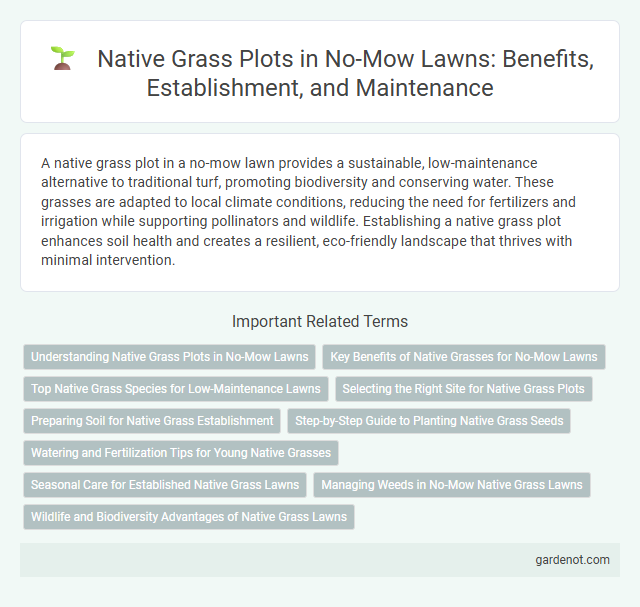A native grass plot in a no-mow lawn provides a sustainable, low-maintenance alternative to traditional turf, promoting biodiversity and conserving water. These grasses are adapted to local climate conditions, reducing the need for fertilizers and irrigation while supporting pollinators and wildlife. Establishing a native grass plot enhances soil health and creates a resilient, eco-friendly landscape that thrives with minimal intervention.
Understanding Native Grass Plots in No-Mow Lawns
Native grass plots in no-mow lawns consist of indigenous grass species that require minimal maintenance and thrive in local climate conditions. These grasses promote biodiversity, improve soil health, and support local wildlife by providing habitat and food sources. Proper establishment involves selecting region-specific grasses, preparing the soil, and allowing natural growth cycles without regular mowing.
Key Benefits of Native Grasses for No-Mow Lawns
Native grasses in no-mow lawns provide exceptional drought tolerance, reducing water consumption by up to 50% compared to traditional turfgrass. Their deep root systems improve soil health and prevent erosion, enhancing ecosystem stability. Low maintenance needs and natural pest resistance minimize chemical use, promoting a sustainable and eco-friendly landscape.
Top Native Grass Species for Low-Maintenance Lawns
Top native grass species for no-mow lawns include Buffalo Grass, Blue Grama, and Fine Fescue, known for their drought tolerance and minimal mowing requirements. These grasses create dense, resilient turf that conserves water and supports local ecosystems while reducing maintenance costs. Incorporating these species enhances lawn sustainability and promotes biodiversity in residential landscapes.
Selecting the Right Site for Native Grass Plots
Selecting the right site for a native grass plot involves evaluating soil type, sunlight exposure, and drainage conditions to ensure optimal growth. Native grasses thrive in well-drained soils with full to partial sun, minimizing maintenance needs in a no-mow lawn setting. Avoiding areas prone to waterlogging or heavy shade enhances plant health and supports biodiversity within the landscape.
Preparing Soil for Native Grass Establishment
Preparing soil for native grass establishment requires thorough site assessment to ensure proper drainage and nutrient balance, promoting optimal root growth. Incorporating organic matter and avoiding soil compaction enhances microbial activity and water retention, crucial for native grass survival. A pH range of 6.0 to 7.5 supports nutrient availability, while minimal soil disturbance preserves native seed banks.
Step-by-Step Guide to Planting Native Grass Seeds
Planting a no-mow lawn with native grass seeds begins with selecting species suited to your local climate, such as blue grama, buffalo grass, or little bluestem. Prepare the soil by removing debris, loosening the top layer, and ensuring good drainage to enhance seed germination. Distribute seeds evenly, lightly rake the area, and maintain consistent moisture through regular watering until the grass establishes deep roots and a resilient, low-maintenance lawn develops.
Watering and Fertilization Tips for Young Native Grasses
Young native grasses in no-mow lawns require careful watering to establish deep roots, favoring infrequent, deep watering sessions over daily light sprinkling to promote drought resistance. Applying a balanced, slow-release fertilizer with low nitrogen content during early growth stages supports healthy establishment without encouraging excessive top growth. Monitoring soil moisture is crucial, ensuring it remains consistently damp but not waterlogged to prevent root rot and foster robust development.
Seasonal Care for Established Native Grass Lawns
Established native grass lawns require seasonal care involving light mowing or trimming during late winter to prepare for spring growth. Applying selective weed control in early spring helps maintain grass health without harming native species. Regular monitoring for pests and minimal supplemental watering during dry periods ensures the lawn's resilience and ecological balance.
Managing Weeds in No-Mow Native Grass Lawns
Managing weeds in no-mow native grass lawns requires targeted strategies such as regular monitoring and selective hand-pulling to preserve native species' health. Applying organic mulch around native grass plots helps suppress weed growth by limiting sunlight exposure to weed seeds. Introducing competitive native plants further reduces weed invasion by occupying available resources and space, maintaining a balanced and thriving lawn ecosystem.
Wildlife and Biodiversity Advantages of Native Grass Lawns
Native grass lawns provide essential habitats for local wildlife, supporting pollinators, birds, and beneficial insects. These lawns enhance biodiversity by maintaining the natural ecosystem balance and promoting soil health through deep root systems. Establishing native grass plots reduces the need for chemical inputs and irrigation, creating a sustainable and ecologically rich landscape.
Native grass plot Infographic

 gardenot.com
gardenot.com